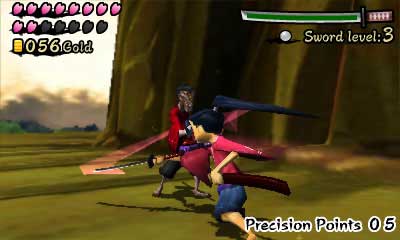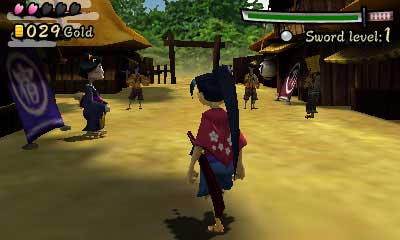Fun and intuitive mechanics; visceral, reflex-based gameplay
Rather short
Sakura Samurai: Art of the Sword came as something of a surprise to me. Between its quiet announcement on Nintendo’s website and its relative lack of publicity (at least compared to some other eShop releases), it seemed as though the game was destined for mediocrity. And yet (to prove the extent of my fanboyism), the simple fact that it was published by Nintendo was enough to pique my interest. It’s true that not every title the company stamps its name on turns out to be a classic, but more often than not the games that Nintendo chooses to publish have some unique characteristic to them that sets them apart from other releases on the market. Such, fortunately, is the case with Sakura Samurai. Beneath its stylized exterior lies an immensely satisfying experience quite unlike any other on 3DS, making it another excellent addition to the console’s growing library.
From the outset, it’s clear that Sakura Samurai is firmly rooted in the Punch-Out!! school of design. Like Nintendo’s cartoon boxer, Samurai’s gameplay can be broken down to pattern recognition, timing, and countering, and players will have to master all of these skills if they hope to rescue the abducted Princess Cherry Blossom and restore order to the land.

The game itself is divided up into stages, which are laid out on a world map a la New Super Mario Bros. Each stage contains a different combination of enemies for you to defeat, using your reflexes (and a handful of items at the ready on the D-Pad) to sidestep their attacks and retaliate with your own. It’s impossible to describe just how satisfying it is to cut down wave after wave of foes, chambara-style, with well-timed counterattacks– you truly feel like a master samurai making short work of petty street thugs. And you’ll want to counterattack as often as you can– each perfect dodge you execute nets you Precision Points, which can be redeemed for cash at one of the small towns dotting the landscape.
These towns are also the only means of saving your progress (via the traditional inn) as well as purchasing new items for your inventory, making them indispensable to your journey. You’ll find yourself retreating to the nearest one after every few stages to stock up on restoratives and whetstones (for when your blade inevitably chips). Beyond that, you’ll also be able to participate in a variety of different mini-games here, which will earn you stamps (that, in turn, can be redeemed for more powerful special attacks), as well as upgrade your sword at the local forge. It is, admittedly, a shame that greater pains haven’t been taken to differentiate the towns (each is essentially a single corridor populated by the same characters, with only the order of the buildings switched up between them), but given the game’s emphasis on combat, this is a minor complaint.

In fact, Sakura Samurai’s only real failing is its length. With a little persistence, the game can be completed in a single sitting, making it almost the antithesis to Nintendo’s other eShop title, Pushmo, which is infinitely replayable thanks to a constant supply of user-generated puzzles. It doesn’t help that Samurai’s only post-game offerings come in the form of marathon runs and the brutally hard Expert mode. The latter, especially, is unlikely to inspire a second playthrough: not only have enemies been buffed up, doling out twice as much damage as they normally would, but a slew of other tweaks have been made to increase the game’s difficulty. Levels, for instance, no longer reward you with sakura petals (Samurai’s equivalent of Heart Containers) on their completion; now you must weather the game’s trials with only the base amount of health at your disposal (a feat that would make even Link, with all those three-heart runs under his belt, sweat). Likewise, the town vendor has seen fit to jack up the prices of his wares, particularly the kappa amulet (which instantly revives you the moment you are defeated) and the invincibility cloak. He also seems to have sold out of his stock of health-restoring rice balls, not that it makes much of a difference; with only a scant three hearts to your name, even the weakest blow will fell you instantly. These changes make Expert mode feel more an exercise in masochism than a reward for completing the game, but fans who enjoy a good challenge will surely revel in the chance to test their swordsmanship under such extreme conditions.
Despite its short length, Sakura Samurai is still a deeply satisfying title that belongs in every 3DS owner’s collection. Its fun and addictive gameplay will hook you the moment you begin the adventure, and you’ll be hard-pressed to put it down until it’s over. While it would have been nice to have a few more stages to clear before the final confrontation, it’s hard to fault the game for not wanting it to end, especially when what is here is already so enjoyable. Anyone with a penchant for reflex-based gameplay (and a few digital bucks to spend) need look no further for their next eShop purchase.




 ShareThis
ShareThis







The eshop is getting better and better, by the way, who are the developers for this title?
The developers are Grounding Inc., who I personally hadn’t heard of prior to this game. XD